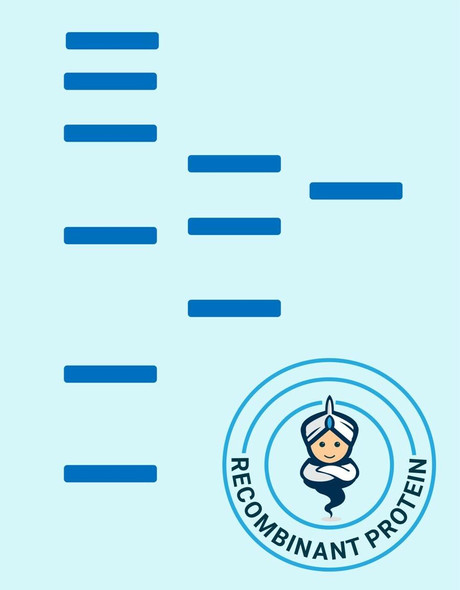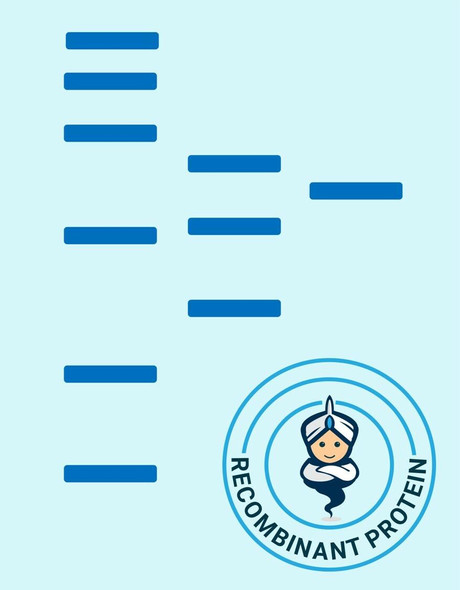Chemokines Recombinant Proteins
Rat MCP 1 Recombinant Protein (RPPB1190)
- SKU:
- RPPB1190
- Product Type:
- Recombinant Protein
- Species:
- Rat
- Uniprot:
- P14844
- Research Area:
- Chemokines
Description
| Product Name: | Rat MCP 1 Recombinant Protein |
| Product Code: | RPPB1190 |
| Size: | 10µg |
| Species: | Rat |
| Target: | MCP 1 |
| Synonyms: | Small inducible cytokine A2, CCL2, Monocyte chemotactic protein 1, MCP-1, Monocyte chemoattractant protein 1, Monocyte chemotactic and activating factor, MCAF, Monocyte secretory protein JE, HC11, chemokine (C-C motif) ligand 2, MCP1, SCYA2, GDCF-2, SMC-CF, HSMCR30, MGC9434, GDCF-2 HC11, Immediate-early serum-responsive JE protein. |
| Source: | Escherichia Coli |
| Physical Appearance: | Sterile Filtered White lyophilized (freeze-dried) powder. |
| Formulation: | The protein was lyophilized from a concentrated (1mg/ml) sterile solution containing no additives. |
| Solubility: | It is recommended to reconstitute the lyophilized Monocyte Chemotactic Protein-1 in sterile 18M?-cm H2O not less than 100�g/ml, which can then be further diluted to other aqueous solutions. |
| Stability: | Lyophilized MCP-1 although stable at room temperature for 3 weeks, should be stored desiccated below -18°C. Upon reconstitution CCL2 should be stored at 4°C between 2-7 days and for future use below -18°C.For long term storage it is recommended to add a carrier protein (0.1% HSA or BSA).Please prevent freeze-thaw cycles. |
| Purity: | Greater than 98.0% as determined by SDS-PAGE. |
| Amino Acid Sequence: | QPDAVNAPLT CCYSFTGKMI PMSRLENYKR ITSSRCPKEA VVFVTKLKRE ICADPNKEWV QKYIRKLDQN QVRSETTVFY KIASTLRTSA PLNVNLTHKS EANASTLFST TTSSTSVEVT SMTEN |
| Biological Activity: | ED50 =1-10ng/ml corresponding to a Specific Activity of 100,000-1,000,000IU/mg. The biological activity was determined by measuring the dose dependent chemotaxis with human THP-1 cells. The optimal concentration should be determined for each specific application by an initial dose-response assay. |
Chemokine (C-C motif) ligand 2 (CCL2) is a small cytokine belonging to the CC chemokine family that is also known as monocyte chemotactic protein-1 (MCP-1). It is found at the site of tooth eruption and bone degradation. In the bone, CCL2 is expressed by mature osteoclasts and osteoblasts and is under the control of nuclear factor kB (NFkB). CCL2 recruits immune cells, such as monocytes, to sites of tissue injury and infection. This chemokine is produced as a protein precursor containing signal peptide of 23 amino acids and a mature peptide of 76 amino acids. It is a monomeric polypeptide, with a molecular weightof approximately 13kDa. As with many other CC chemokines, CCL2 is located on chromosome 17 in humans. The cell surface receptors that bind CCL2 are CCR2 and CCR5.
Monocyte Chemotactic Protein-1 Rat Recombinant produced in E.Coli is a non-glycosylated, Polypeptide chain containing 125 amino acids and having a molecular mass of 14.1 kDa. The MCP-1 is purified by proprietary chromatographic techniques.
| UniProt Protein Function: | CCL13: Chemotactic factor that attracts monocytes, lymphocytes, basophils and eosinophils, but not neutrophils. Signals through CCR2B and CCR3 receptors. Plays a role in the accumulation of leukocytes at both sides of allergic and non-allergic inflammation. May be involved in the recruitment of monocytes into the arterial wall during the disease process of atherosclerosis. May play a role in the monocyte attraction in tissues chronically exposed to exogenous pathogens. By IL1/interleukin-1 and TNF. Widely expressed. Found in small intestine, thymus, colon, lung, trachea, stomach and lymph node. Low levels seen in the pulmonary artery smooth muscle cells. Belongs to the intercrine beta (chemokine CC) family. |
| UniProt Protein Details: | Protein type:Secreted, signal peptide; Secreted; Motility/polarity/chemotaxis; Chemokine Cellular Component: extracellular space; rough endoplasmic reticulum; cell soma; perinuclear region of cytoplasm; endocytic vesicle; cytoplasm; dendrite; extracellular region; synapse; perikaryon; nerve terminal Molecular Function:heparin binding; G-protein-coupled receptor binding; chemokine activity; CCR2 chemokine receptor binding Biological Process: positive regulation of cell adhesion; maternal process involved in pregnancy; positive regulation of leukocyte migration; response to glucocorticoid stimulus; response to lipopolysaccharide; response to antibiotic; monocyte chemotaxis; regulation of cell shape; transforming growth factor beta receptor signaling pathway; response to vitamin B3; negative regulation of neuron apoptosis; response to drug; neutrophil chemotaxis; organ regeneration; response to amino acid stimulus; positive regulation of tumor necrosis factor production; response to ethanol; cellular response to insulin stimulus; response to bacterium; response to heat; response to mechanical stimulus; positive regulation of endothelial cell proliferation; response to activity; response to progesterone stimulus; positive regulation of nitric-oxide synthase biosynthetic process; positive regulation of collagen biosynthetic process; chemokinesis; positive regulation of synaptic transmission; positive regulation of cellular extravasation; positive regulation of cell-cell adhesion; protein kinase B signaling cascade; response to wounding; lipopolysaccharide-mediated signaling pathway; response to gamma radiation; inflammatory response; lymphocyte chemotaxis; aging; cytokine and chemokine mediated signaling pathway; MAPKKK cascade; cytoskeleton organization and biogenesis; glial cell migration; macrophage chemotaxis; leukocyte migration during inflammatory response; cellular calcium ion homeostasis; positive regulation of leukocyte mediated cytotoxicity; negative regulation of angiogenesis; maternal process involved in parturition; response to hypoxia; positive regulation of T cell activation; vascular endothelial growth factor receptor signaling pathway; astrocyte cell migration |
| NCBI Summary: | a monocyte chemoattractant protein [RGD, Feb 2006] |
| UniProt Code: | P14844 |
| NCBI GenInfo Identifier: | 126846 |
| NCBI Gene ID: | 24770 |
| NCBI Accession: | P14844.1 |
| UniProt Secondary Accession: | P14844,Q549R5, |
| UniProt Related Accession: | P14844 |
| Molecular Weight: | 16,460 Da |
| NCBI Full Name: | C-C motif chemokine 2 |
| NCBI Synonym Full Names: | chemokine (C-C motif) ligand 2 |
| NCBI Official Symbol: | Ccl2�� |
| NCBI Official Synonym Symbols: | MCP-1; Scya2; Sigje�� |
| NCBI Protein Information: | C-C motif chemokine 2; small inducible gene JE; small inducible cytokine A2; small-inducible cytokine A2; monocyte chemotactic protein 1; monocyte chemoattractant protein 1; monocyte chemoattractant protein-1; immediate-early serum-responsive JE protein; immediate-early serum-responsive protein JE |
| UniProt Protein Name: | C-C motif chemokine 2 |
| UniProt Synonym Protein Names: | Immediate-early serum-responsive protein JE; Monocyte chemoattractant protein 1; Monocyte chemotactic protein 1; MCP-1; Small-inducible cytokine A2 |
| Protein Family: | C-C motif chemokine |
| UniProt Gene Name: | Ccl2�� |
| UniProt Entry Name: | CCL2_RAT |






